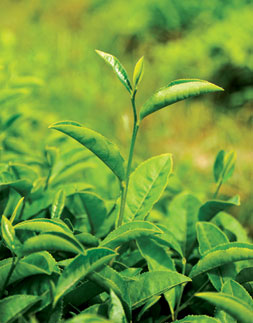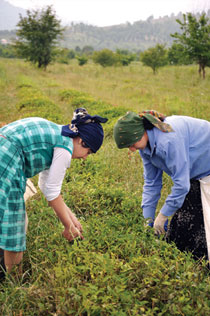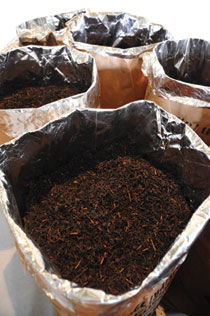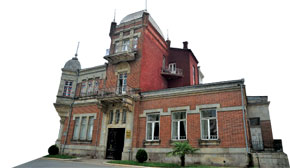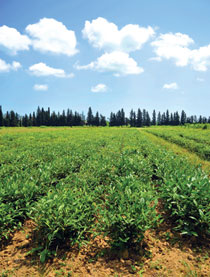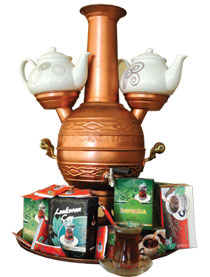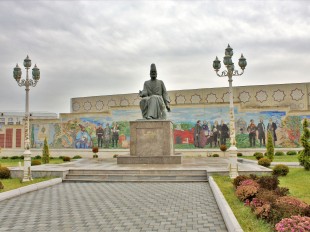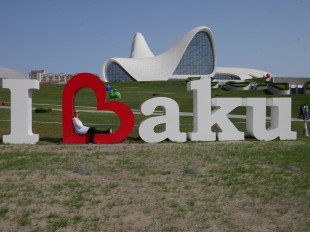Tea lies at the heart of many Azerbaijani traditions. When a boy’s family visits a girl’s family to ask her hand in marriage, tea will certainly be served. If the girl and her family agree to the match, then her father will put sugar into his glass of tea and drink it. This means that the guests should start to make preparations for the wedding. But if the girl and her family do not agree to the match, then the head of the family drinks the tea without any sugar and the guests go home disappointed. The tradition is called ‘shirin chay’ or ‘sweet tea’ and is often followed even nowadays in the era of globalization and social networking.
TEA IN ARMUDU GLASSES
Tea is the most popular drink in Azerbaijan. It’s served at celebrations and at funerals, as a warming drink in winter and a refreshing drink in summer. Tea is not only part of the daily diet, it’s part of the social and cultural fabric for every Azerbaijani. This is particularly evident in the rituals of hospitality.
Immediately on arrival in an Azerbaijani family, a guest is given a glass of tea with sweets and lemon. This is the precursor to the substantial meal that will later be served in their honour. While guests are drinking tea, this gives them time to relax after their journey, chat and share news.
Tea is served in glasses called armudu, a name which translates as ‘pear’. They get their name from their pear-shape, narrower in the middle and wider at the top and bottom. The shape allows the tea at the top of the glass to cool ready for drinking, while the bottom half stays hot.
Azerbaijani men love to get together over a glass or two of tea. In cities, towns and villages across the country you will see chaykhana or tea-houses. Often modest establishments of a few tables and chairs, the tea-houses are considered the best places for men to get together and put the world to rights. Over glasses of tea they discuss politics, social issues and what the neighbours are doing. They share not only news but their problems as well, so some will give advice and others will just listen and show compassion. Tea is the glue holding everything together.
BENEFITS OF TEA
Tea is a name given to many brews, but real tea, as opposed to herb or fruit teas, comes from the Camellia sinensis plant, a shrub native to China and India. The most common kinds of tea are black tea, green tea and white tea and there are also oolong and pu-erh teas. The differences lie in how they are processed, not the plant they come from. All these types of tea have many health benefits.
Tea is high in antioxidants called polyphenols. Antioxidants help to protect and heal cells in the human body, so tea is believed by many to be beneficial in combating cancer and the effects of aging. Tea also contains caffeine and theanine, which affect the brain and seem to heighten mental alertness.
The more processed the tea leaves, the less they have of a type of polyphenol called catechins. Oolong and black teas are oxidized or fermented, so they have lower concentrations of catechins than green tea, but their antioxidizing power is still high. All these components make tea one of the most invigorating drinks. No wonder many people start the morning with a cup of tea. It sets them up for the day.
ORIGINS OF TEA
But what do we know about the origin of tea? Tea began in the Far East and was only introduced to the West a relatively recent 400 years ago. Discovered in China, tea has exerted a profound influence on societies and cultures throughout the world. There are unique ceremonies in many cultures and distinctive social etiquette and customs concerning the preparation and drinking of tea. The origin of the word ‘tea’ lies in the Chinese name for the drink which itself evolved from t'u to ch'a during the 6th century. On its arrival in the West it became close to te which is still the name for tea in many countries.
TEA IN LEGEND
Legend has it that tea was discovered by the Chinese Emperor, Shan Nong, who had a habit of boiling his drinking water. One day while he was in his garden a few tea leaves fell by chance into his boiling water which then gave off a rich, alluring aroma. The Emperor, upon drinking this brew, discovered it to be refreshing and energizing. He immediately gave the command for tea bushes to be planted in the gardens of his palace. Thus the custom began of brewing tea in hot water and quickly spread.
Tea arrived in Europe via Dutch and Portuguese sailors at the beginning of the 17th century. They traded with China and brought the tea to Britain and Holland at the outset, where it was sold at auctions and became very popular among the aristocracy and the wealthy. Its popularity gradually spread and by the 19th century it was a drink enjoyed by all sections of society. Today the turnover of the tea industry worldwide is more than three billion dollars a year.
Tea is grown and produced in more than 30 countries, one of which is Azerbaijan. Several regions of Azerbaijan have the right conditions for the cultivation of tea – Lenkeran, Astara, Masalli and Lerik in the south and Zagatala in the north-west of Azerbaijan. These areas are thought to have a total of 29,000 hectares suitable for the cultivation of tea.
LENKERAN , LAND OF AZERBAIJANI TEA
The region of Lenkeran (Lənkəran) in the south of Azerbaijan is famed for its lemon and tea plantations. Climatic conditions and, most importantly, humidity make this region favourable for the cultivation of tea. Visions of Azerbaijan made its way to Lenkeran to find out more about the Azerbaijani land of tea.
First, about Lenkeran itself . Lenkeran is the name of both the town and surrounding region. The town, with a population of 50,000, lies on the Caspian coast, near the border with Iran. Many of the people of Lenkeran are Talish, an ethnic group with its own language, closer to Persian.
Lenkeran is becoming more urban. New buildings are being constructed, including hotels and entertainment centres. Year by year Lenkeran is turning into a resort area. Close to the Talish Mountains and washed by the Caspian Sea, it has the right climate. While tea and citrus plantations lie outside the city, lemon trees grow everywhere, including on the city streets.
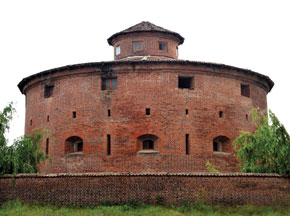 A former prison which once housed Joseph Stalin. The tower was originally part of Lenkeran’s 18th century fortress
A former prison which once housed Joseph Stalin. The tower was originally part of Lenkeran’s 18th century fortressLenkeran’s origins are lost in history. Various Western travellers referred to the town in the 16th and 17th centuries. Laurence Chapman, from the English-Russian Muscovy trade company, wrote that he visited the town of Laygon in 1568-69, while German traveller Adam Olearius visited some 60 years later. At that time Lenkeran was a small settlement of several hundreds of houses.
It became the centre of the Talish khanate in the 18th century. Qara khan (1747-1786) engaged foremen and architects for construction work. Alongside the new building, the town’s economic, political and cultural life started to develop. Crafts became important in the town’s economy with blacksmiths, potters, copper-workers and jewellers thriving. Lenkeran was an important trading post on routes to Iran, Central Asia and India.
The town’s strategic location also made it attractive to the Persian and Russian empires. Russia briefly took the town in the 18th century before finally seizing control from the Persians in the 19th. The Russians abolished the khanate in 1826.
Years later, Lenkeran became the main area in Azerbaijan for the cultivation of rice, tea, citrus fruit and vegetables. The land has some 30,000 hectares of woods and is rich in mineral springs. The district is an important producer of spring and winter vegetables. Rice, grapes, tobacco, citrus fruits and oak trees thrive in the warm, humid climate. However the main crop is tea, which is processed at local tea factories. Other industries are food processing, timber, furniture manufacture, silk and carpet weaving.
LENKERAN’S NOTORIOUS PRISONER
Walking through the streets of Lenkeran, you can see a number of historical sites. Two cylindrical towers are all that remain of the 18th-century fortress, destroyed by Russian troops in 1812. One whitewashed tower is located in the north-east of the town, near the railway station, and the second red-brick structure is more central, on the road to the football stadium. Both towers served as jails and housed a number of famous prisoners, including Joseph Stalin and Azerbaijani Communist Party leader Mirjafar Baghirov.
Right in the city centre is the House of Mirahmad khan, a descendant of the Lenkeran khans who were allowed to keep their titles. One of the most beautiful buildings in Lenkeran, the palatial house skilfully combines elements of local and European architecture. Completed in 1913, the house is now a museum.
Lenkeran is a tourist paradise. Good infrastructure, beautiful scenery, fresh air, hospitable people and good food. What more do you need?! No wonder it’s known as the home of centenarians, where some residents even live to be 120.
Fish is a mainstay of Talish cuisine and a favourite fish dish is lavangi, fish stuffed with nuts and raisins.
TEA PLANTATIONS
Many of the tea plantations are just south of Lenkeran in Astara District, which used to be part of Lenkeran. The climatic conditions are better suited to tea cultivation, and the district is not so urbanized. There are a number of tea-producing companies, one of which is Gilan Holding. Visions of Azerbaijan visited its new tea factory in Lenkeran and its tea plantations in Astara.
The region is mountainous, the hills covered in a rich green velvet which is pleasing to the eye. The saturated colours would have delighted Van Gogh or Gauguin and they don’t leave anyone unmoved. Even this writer could not resist the temptation to take up a brush and paint her impressions.
The Gilan plantations that we visited are located in the highlands. Since access is by a dirt road, we took a Niva, a Soviet jeep, that was ideal for the terrain. The friendly driver told us how the Talish of Astara differ from those in Lenkeran; even their language has different slang, though they all used to lived in one region called Lenkeran. When we finally got to the plantations, several women were picking tea leaves. The tea is picked by hand and it’s hard work. Imagine spending a whole day bent double under the sun to gather in the precious leaves.
GREEN HARVEST
Tea-picking demands professional skills as well. Only the top three leaves can be picked, because only they are suitable for tea production. The remaining leaves are considered unusable, so they are left on the bushes for photosynthesis which is also important for the plants. Tea picking is done several times a year, as a rule in spring and summer when the new leaves come out. It is mainly women who are involved in this work. For 57-year-old Fatima khala, it is a way of life. Her mother and grandmother picked tea before her. Now she and her daughter are helping tea production. I’ve been doing it for as long as I can remember. It’s a kind of family business. We used to pick more tea leaves (15-20 kilo per day), because tea growing was quite successful. We were certainly tired in those days, but now there is not a lot of work.
FIRST TEA BUSHES IN AZERBAIJAN
Fatima khala was right. Tea production used to be a major industry in Azerbaijan. However, with the collapse of the USSR and Azerbaijan’s independence, tea production went into decline. We asked Muhendis Jahangirov, director of Gilan Tea Factory, why it happened. First, he told us a little about the history of tea in Azerbaijan. The first tea bushes were planted in Azerbaijan in 1912. But tea-growing acquired commercial value in the 1930s. In 1934 Lenkeran was visited by specialists from Moscow who took samples of the soil. Analysis of these samples revealed the most favourable areas for tea-growing. Since that time, tea factories have been operating in Lenkeran and neighbouring regions.
Tea-cultivation reached its peak in Soviet Azerbaijan in the 1980s, when 34-38,000 tonnes of tea leaves were harvested annually. Tea-growing dropped sharply when the collective and state farms broke up after the collapse of the USSR. The cultivated area began to shrink, so the harvest declined each year. The lowest point came in 2007-2008, when the harvest was under 500 tonnes.
WALK THROUGH A TEA FACTORY
The tea factory that we visited in Lenkeran has several departments: raw leaf processing, leaf drying, sorting and packing. The factory opened in 2010 with new equipment brought from China. It can process up to 1.5 tonnes of tea per day. We were lucky. We arrived soon after freshly picked leaves had been delivered.
First, the leaves have to wilt. We saw large racks of tea in the raw processing department left out to wilt and wither. Their thick aroma followed us throughout the factory and beyond. As the leaves wither, they lose some of their moisture and become soft and supple. The withered leaves then go through a process known as maceration. They are squeezed and twisted in special containers, so that their natural juices, or enzymes, are released and on contact with the air will oxidise. The resulting mass is sent for drying after which the leaves are sorted. The larger leaves are packed separately from the smaller ones. The sorted tea is then cleaned of unwanted substances before the final, packing, stage.
Azerbaijan both imports and exports tea. The imports usually come from India, the UAE and UK. Some tea is imported raw and processed in local factories, while other high-quality varieties and brands are imported for direct sale. The country’s demand for processed tea is about 15,000 tonnes annually. Azerbaijan doesn’t cover even half this amount, so imports are essential.
THERE ARE PROBLEMS AND THERE IS HOPE…
Tea factory director Muhendis Jahangirov says that the area covered by tea plantations has fallen. According to statistics, in 1988 some 14,000 hectares were sown to tea and harvest was at its highest. In 2007, only 1,700 hectares of tea plantations remained, and in 2011 the area was down to 600 hectares. You know, tea-growing has a specific character. It requires long-term investment. Tea bushes give a first crop only seven years after they have been planted. And a normal yield takes 10 years. So you can see that the recovery of the tea plantations demands a long time and resources. The conditions for domestic bank loans don’t encourage tea growing either. There should be strong action by the government to develop tea plantations.
However, over the last four years slight improvements can be seen. According to figures from Azerbaijan’s State Statistics Committee, 450 tonnes of tea were produced in 2009, 540 tonnes in 2010, 530 tonnes in 2011 and over 550 tonnes in 2012. As Mr Jahangirov said, the situation is moving in the right direction.
Another problem facing the tea industry in Azerbaijan is a lack of tea experts, Mr Jahangirov said. Few professionals are left in this field who can share their knowledge and practice. But the problem is that we don’t have a basis for the development of tea specialists. We need to create a special school or department inside a university to allow young people to become professional in tea-growing. In my time we studied in Georgia at the Kutaisi Subtropical Institute on Tea Production that was the only professional educational centre in the post-Soviet area. We could use its experience and create a similar institute in Azerbaijan. In fact, we could be the tea country in future, why not?! Azerbaijan is a place where tea is respected. As they say, tea is God’s drink…and that’s true.
